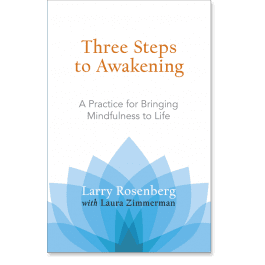 Larry Rosenberg’s latest book came out in 2013 and I am just getting to it. I’ve been holding offer, like saving something precious that you know will likely not be replaceable. Larry is now in his 80s, and while he certainly may publish another book, this may be his last. It’s been a delicious pleasure to visit with my first mindfulness teacher.
Larry Rosenberg’s latest book came out in 2013 and I am just getting to it. I’ve been holding offer, like saving something precious that you know will likely not be replaceable. Larry is now in his 80s, and while he certainly may publish another book, this may be his last. It’s been a delicious pleasure to visit with my first mindfulness teacher.
Larry comes from a skeptical, educated, and intelligent perspective. He is a no nonsense guy from Brooklyn who cuts through hype to get to the heart of the teachings.
Three Steps to Awakening: A Practice for Bringing Mindfulness to Life is largely based on Larry’s talks at the Cambridge Insight Meditation Center, some of which I’ve likely attended over the years. The book has his warm, direct, conversational tone that I so appreciate in his teachings. Larry is very funny and his humor is upaya–skillful means–that makes the Buddha’s teachings more available to people. I laughed out loud when I read this passage:
Interested in religion? What kind? Buddhism? What flavor? Vipassana? Oh, you’ve tried that? A little too dry, perhaps to much talk about suffering and impermanence? You might prefer Dzogchen, the innate perfection of the mind. Besides, most vipassana teachers are not even monks; they just wear sweatpants …
As the title suggests, Larry’s approach is practical–meaning practice based. He presents methodology grounded in the Buddha’s original teachings that are just as relevant today as they were 2500 years ago (mostly because we still have bodies that breathe).
In this book, he condenses the 16-part Buddha’s teaching of the anapanna sati to 2-parts. It’s not meant as an economical short-cut for busy yogis. Rather, it is a distillation of the practice in a way that makes it more available and less likely to distract (after all, think of all the perfectionism you might bring to bear on a method with 16 steps!).
Let’s look briefly at the first part. The Buddha said, “Being sensitive to the whole body, the yogi breathes in. Being sensitive to the whole body, the yogi breathes out.” When you focus on your breathing, you don’t lock it down tight on any one or more features of the breathing apparatus. Instead, you place the breath in the context of the wider, where it actually resides.
Investigate this the next time you do some breathing meditation. The breath is obvious at the nose, the mouth, throat, chest, and abdomen. But where exactly do the sensations linked to these anatomical parts end and the rest of the body begin. As you pay attention, you may notice a feeling of spread, as if the breath expands into your entire head, neck, and torso.
If you pay very careful attention for prolonged periods of time, you may also notice that the whole body participates in the process of breathing as the blood flows carrying oxygen. We are breathing bodies. The Buddha knew this and he took this awareness all the way to awakening.
We can do the same.
Three Steps to Awakening is a valuable read that can deepen and further your practice as it has done for my practice. It also contains questions and answers from students and I find this is the best way to teach and learn the dharma–the lessons of the Buddha and the truths these lessons point towards.

